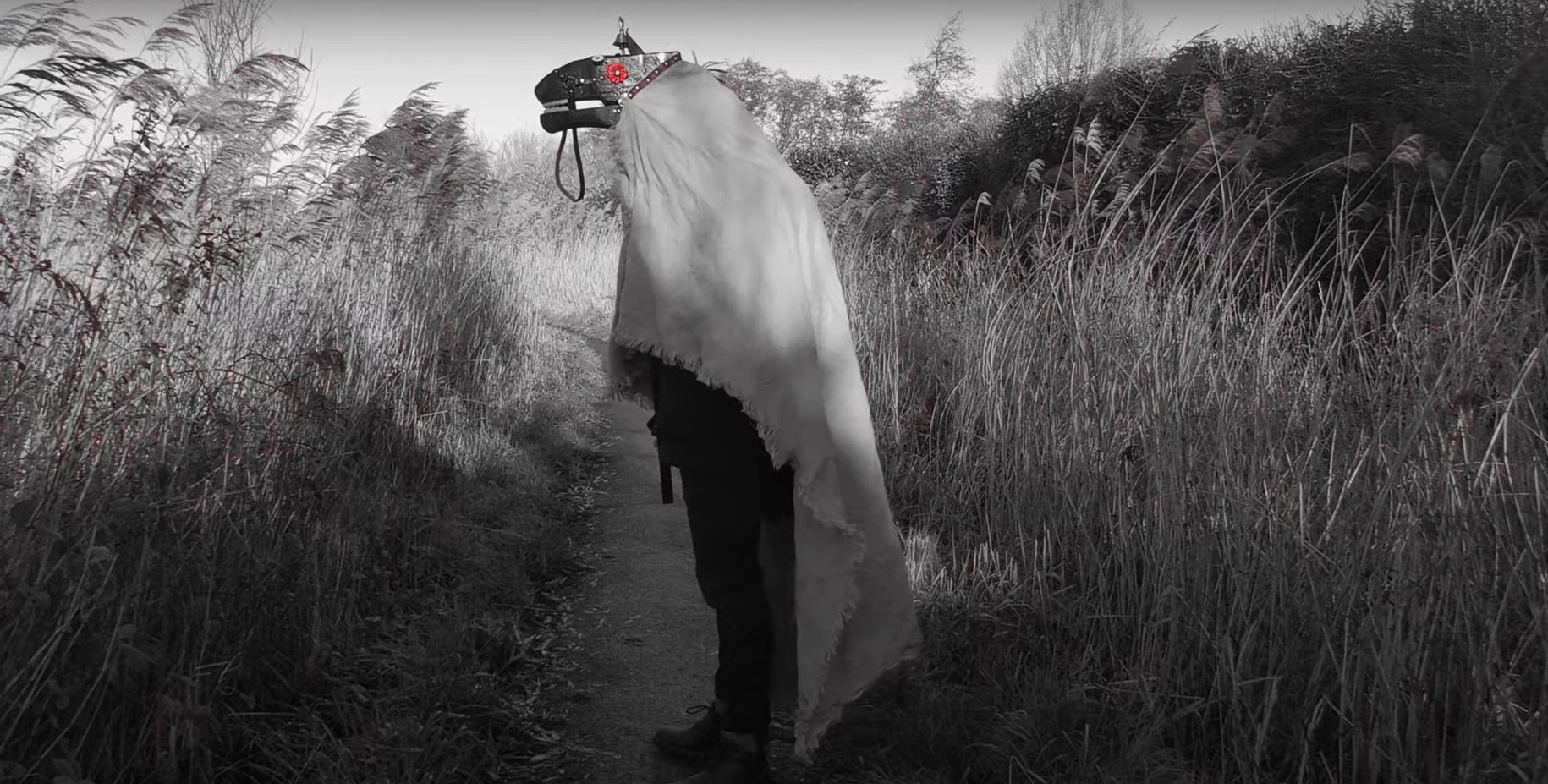In Poor Old Horse, Sonia Overall explores the relationship of the Hoodening custom to the landscape of its origin through walking and embodied experience, spoken word, and the re-visioning of archival material and traditional music.
This walking piece is one of the shortlisted pieces in the Marŝarto Awards 2023. Here, Sonia discusses her work.
‘Poor Old Horse’ is a walking poetry film. The piece explores the relationship of the Hoodening folk custom to the landscape of its origin, in East Kent, UK. The film employs walking to capture an embodied experience of place and reflect the practice of early Hoodening teams. Alongside footage of walking in the landscape, ‘Poor Old Horse’ features spoken word generated through my ambulant writing practice, alongside the re-visioning of archival material and traditional folk music.
Hoodening as perambulating performance
Hoodening is an East Kent house-calling custom associated with the Christmas season. It is a tradition rooted in agricultural practices, working class culture and the Kent landscape. Hoodening features the figure of the Hooden Horse, a form of mast-style animal guising particular to East Kent. Parallel practices exist around the UK, including the Welsh Mari Lloyd, featuring a horse skull disguise, and the Derby Tup, which uses a ram figure. Echoes of similar animal guising customs can be found across Europe.
Poor Old Horse explores three elements of the Hoodening tradition that particularly interest me: the connection of the Hooden Horse to its indigenous landscape; the weird atmosphere created by the presence of this strange, hybrid creature; and the physical experience of 19th and early 20th Century Hoodening teams, who walked long distances in costume carrying the Hooden Horse, and performed multiple times in an evening – all after a day’s work.
Sources from the 19th century, gathered by the historian Percy Maylam, record Hoodeners calling at houses, pubs and workplaces. Here they performed songs and music in return for money, food and drink, a much-needed bonus during the lean winter months when resources were scarce. Performance skits evolved with the introduction of additional characters drawn from horse-handling and farming practices, including the Waggoner, who manages the horse and boasts about its prowess, and the Rider, who mocks, attempts to mount the horse, and is thrown off. Later scripted performances, common to revival Hoodening teams, merge elements of traditional mumming plays, bringing in the Molly and Doctor characters. The result is a variety of folk theatre centred around the comic death and resurrection of the Hooden Horse.
As an occasional Hooden Horse and Doctor, and a frequent Hoodening musician and Waggoner, I have a tactile relationship with the Hooden Horse. I have also created and adapted Hoodening scripts for performance. This film brings together my experience of and delight in the custom with the realities of walking the East Kent landscape in midwinter, with its dark skies, early evenings and frost-covered, puddle-strewn paths.
Methods, Sources and Composition
‘Poor Old Horse’ draws on creative research methods including walking with text and objects, and my ambulant writing practice. I generated much of the spoken text while walking in the Hoodening-soaked landscape near my home in Sandwich, where I also captured the film footage. Research into the tradition reveals that a Hoodening team were based at a farm a short walk from where I live: these performers would have worked in the fields and orchards where I frequently walk. The farm environs, including the farmhouse, old stable block and gates, and the surrounding orchards feature in walking and static footage in the film. The walk itself takes in a route the Hoodening team would have taken to the next village, then across fields to the nearest town.
Sections of the film respond directly to documentary sources. Percy Maylam’s account of the strange magic of witnessing Hoodening as a boy comes from his book The Hooden Horse, published in 1909. I used the transcript of a 1980 interview with Tom West, an early 20th century performer with the St Nicholas at Wade Hoodening team, to create his section of reminiscences. The character of Tom West is voiced by a local storyteller, Tony Cooper.
The soundtrack is the result of collaborative experimentation with local folk musicians, using songs I researched and collected from historical folk play scripts and horse shanties. We took an afternoon together in a music practice room at my institute with some simple recording equipment, and riffed on variations of the songs. I used some of the resulting solo and group improvisation, including experimental percussion, to create the sound of a Hoodening team preparing and performing. I then layered looped improvisation tracks on hurdy gurdy and fiddle to create an atmospheric soundscape for moments when the Hoooden Horse appears in the landscape.
Funding and screening
‘Poor Old Horse’ was commissioned as part of the Canterbury Christ Church University research project Celebrating the Kentish Hooden Horse, in conjunction with the exhibition Animal Guising and the Kentish Hooden Horse at Maidstone Museum, UK, curated by my collaborator and partner James Frost. The project and film were made possible through support from Arts Council England, The National Lottery Heritage Fund and Canterbury Christ Church University. The film was screened in the Maidstone Museum exhibition from February to June 2023, and is part of the digital legacy of the project held in national folk archives.
The winners and honourable mentions of the Marŝarto Awards 2023 will be announced in February 2024.


